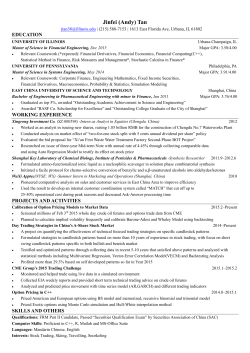
What Is Heikin-Ashi (1)
What Is Heikin-Ashi and How to Trade with It? by Vahid | Technical Analysis | Monday, February 25th, 2008 In forex or stock market, we can make or lose money when the price goes up and down. We need to be able to predict the direction of the market. Different traders do this using different methods but for most traders, technical analysis of the price charts is the easiest way. So they spend a lot of time to learn technical analysis. In fact, technical analysis was invented and introduced by Japanese traders and by the invention of the candlesticks. Those who are familiar with the candlestick charts know that it is the best and fastest way for understand the condition of the market and the psychological situation of the buyers and sellers. Japanese traders didn’t stop improving their technical analysis methods and tools. They worked a lot and tried to make the technical analysis and price prediction easier and faster and Heikin-Ashi chart that came after the candlestick chart is one of the several different achievements of Japanese traders. I can not say that you can predict faster using the Heikin-Ashi charts but it is easier than candlestick charts. In this article, I explain about the Heikin-Ashi charts signals and analysis and will compare it with the candlestick charts and then talk about my personal opinion about Heikin-Ashi charts and the way that you can use them in your trades. Note: Click here to learn how to add the Heikin Ashi indicator to your chart. So What Is a Heikin-Ashi chart and how does it look like? Heikin-Ashi chart looks like the candlestick chart but the method of calculation and plotting of the candles on the Heikin-Ashi chart is different from the candlestick chart. In candlestick charts, each candlestick shows four different numbers: Open, Close, High and Low price (It is recommended to learn the candlesticks first) and each candlestick is independent and has no relation with the previous candlestick. But Heikin-Ashi candles are different and each candle is calculated and plotted using some information from the previous candle: 1- Close price: the close price in a Heikin-Ashi candle is the average of open, close, high and low price. 2- Open price: the open price in a Heikin-Ashi candle is the average of the open and close of the previous candle. 3- High price: the high price in a Heikin-Ashi candle is chosen from one of the high, open and close price of which has the highest value. 4- Low price: the high price in a Heikin-Ashi candle is chosen from one of the high, open and close price of which has the lowest value. So candles of a Heikin-Ashi chart are related to each other because the close and open price of each candle should be calculated using the previous candle close and open price and also the high and low price of each candle is affected by the previous candle. So a Heikin-Ashi chart is slower than a candlestick chart and its signals are delayed (like when we use moving averages on our chart and trade according to them). What are the advantages and disadvantages of this delay? This delay has made the Heikin-Ashi candle as a good indicator for volatile currency pairs like GBP-JPY because it prevents us from rushing and making mistakes amd trading against the market. Lets see how a Heikin-Ashi chart looks like and compare it with a candlestick chart: The above chart has two parts. The upper part is the Heikin-Ashi chart and the lower part is the candlestick chart. Numbers 1 and 2 in the candlestick chart show a sell signal whereas if you compare the candlesticks number 1 and 2 with the Heikin-Ashi candles number 1 and 2, you will see that the Heikin-Ashi candles don’t show any sell signal yet. It is just the candle number 3 that shows a signal. So the Heikin-Ashi candles are about one or two candles delayed. If I wanted to trade using the above chart and with the candlestick chart signals, I would go short when the candlestick number 3 would break the low price of the candlestick number 2 whereas if I wanted to trade only using the Heikin-Ashi chart, I would have to wait for the candlestick number 4 to be formed. In other part of the chart, the candlesticks number 5, 6, 7, and 8 made another good sell signal. I would go short when the candlestick number 9 broke the low price of the candlestick number 8. But with the Heikin-Ashi chart, I would have to wait for the candle number 9 to be formed completely and also the next candle to break the low price of the candle number 9. So the Heikin-Ashi chart is delayed and the candlestick chart is much faster and helps us to make more profit. So why should we use a Heikin-Ashi chart? As I have already explained, because of the delay that the Heikin-Ashi chart has, it has less number of false signals and prevent us from trading against the market. On the other hand, Heikin-Ashi candles are easier to read because in contrast with the candlesticks they don’t have a lot of different shapes and formations. Different candles in a Heikin-Ashi chart: 1- Bullish candles: When the market is Bullish, Heikin-Ashi candles have big bodies and long upper shadows but no lower shadow. Look at the big uptrend in the below chart. As you see almost all of the candles have big bodies, long upper shadows and no lower shadow. 2- Bearish candles: When the market is Bearish, Heikin-Ashi candles have big bodies and long lower shadows but no upper shadow. Look at the big downtrend in the below chart. As you see almost all of the candles have big bodies, long lower shadows and no upper shadow. 3- Reversal candles: Reversal candles in the Heikin-Ashi charts look like Doji candlesticks. They have no or very small bodies but long upper and lower shadows. Look at the reversal candles in the below chart: How can you use the Heikin-Ashi chart in your trades? I know that some traders only use Heikin-Ashi to trade but I don’t agree with it. As you saw Heikin-Ashi is delayed. So it is good for trading volatile currency pairs like GBP-JPY and with small time frames. It is good for intraday trading and scalping using small time frames like 5 minutes or 2 minutes. It is not suitable for big time frames like daily and 4 hours because you will be too late in many cases and so you have to close your trade before you make any profit. Have both the candlestick and Heikin-Ashi on your chart and add a 14, 7, 3 Stochastic. Buy when both of the Stochastic fast and slow lines go up from the oversold area and at the same time both the candlestick and Heikin-Ashi charts show reversal signals. Sell when both of the Stochastic fast and slow lines go down from the overbought area and at the same time both the candlestick and Heikin-Ashi charts show reversal signals. Look at the below 2 minutes chart and see two short trade and one long trade opportunities: Two good trades in the 15 minutes chart: A good short trade in 5 minutes chart: A good long trade in the 5 minutes chart: Keep in your mind that you have to try any new system with the demo account and if it worked, you can use it with the real account. Please use the below form to submit your questions or comments and I will answer as soon as possible.
© Copyright 2025








